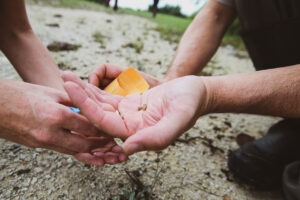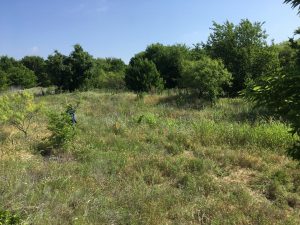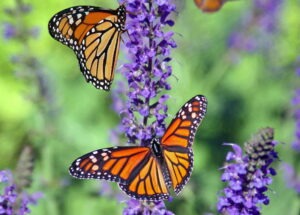<<back to Texas Plant Conservation Program
Post-Conference Summary
BRIT hosted the virtual 2020 biennial meeting of the Texas Plant Conservation Conference (TPCC) 13-14 August 2020. The goal of this year’s conference was to KEEP CONNECTED to our conservation community, especially important during a historic global pandemic. The meeting was held using the Slack platform with pre-recorded talks, digital posters, and live chat-based Q&A sessions with the presenters. There were 47 presentations: 22 pre-recorded talks and 25 posters, with 15 presentations entered into the student competition. The virtual conference netted 146 registrants, double the total of each of the last two in-person conferences. Ninety organizations participated, including state agencies, universities, non-profits, botanic gardens, and Texas Master Naturalist chapters. BRIT, Tarleton State University, University of North Texas, and Texas Parks & Wildlife Department had the most participants, with 6 or more individuals attending from each. Overall, we witnessed engagement by attendees with all presenters and were pleased that the switch to chat-based interaction appeared to improve accessibility for a number of attendees.
2020 Texas Plant Conservation Conference Student Awards
Best Poster Presentation
*Texas Little Bluestem (Schizachyrium scoparium) Phenotypic Attribute Correlations to Collection Site Environment Characteristics – Kimberlee N. Howell, James P. Muir, Darrel B. Murray, Adam B. Mitchell, John R. Bow
*Endofungal Bacteria Isolated From Mycorrhizal Fungi in a North American Terrestrial Orchid – Kris Petterson, Jaspreet Kaur, Jyotsna Sharma
Best Video Presentation
*Examining the Efficacy of Stock-Piling Topsoils and Seeding for the Restoration of Native Grasses – Dustin A. Golembiewski, Sandra Rideout-Hanzak, David B. WesterBest Presentation by an Undergraduate
*Overview of the University of North Texas Pecan Creek Pollinative Prairie: An Undergraduate Education Experience Aiming to Reconstruct a Native, North Central Texas Prairie in an Urban Setting – Clarissa Molina, Savannah Thomas, Jaime Baxter-SlyeHonorable Mention for Creative Poster Design
*Cover Crop Considerations for Rangeland Restoration – Brianna M. Slothower, Anthony D. Falk, Sandra Rideout-Hanzak, Terry Blankenship, David B. Wester
Schedule of Events
Thursday, 13 August 2020
1-2 PM Session 1: Floristics
2-3 PM Session 2: Monitoring
3-4 PM Session 3: Ecology
Friday, 14 August 2020
1-2 PM Session 4: Restoration
2-3 PM Session 5: Genetics and Seed Conservation
3-4 PM Session 6: Strategies and Networks

View the full program and abstracts here.
Thursday, 13 August 2020
1 – 2 PM Session 1: Floristics
- Rediscovery of Dendrothele (white crust fungus) in North Texas: The Importance of Urban Tree Preservation – Ashley Bordelon, Harold W. Keller, Robert J. O’Kennon
- Predictive Mapping of Rare Plants in Texas – Jordan Craven, Hemanta Kafley, Darrel Murray, Heather Mathewson, Kim Taylor
- Biodiversity of the Pecan Creek Pollinative Prairie: A Classification of Observational Data (2016-2020) – Zoe A. Gilbert, Carson D. Nick, Jamie Baxter-Slye,
- Update on the Illustrated Flora of East Texas – Barney Lipscomb
- Monarda viridissima at Notch Cutter Wildlife Habitat Preserve – Minnette Marr, Betty Henley, Judy Turner
- Mapping the Impact of Climate Change on Spatial Distribution of Dalea reverchonii, an Endemic Plant – Madhushree Munsi, Kim Norton Taylor
- Recent Additions to the Threatened and Endangered Plant List of Texas – Anna W. Strong
- Updating BONAP Maps for the State of Texas – Liz Pullman, Judy Turner, Misako Nishino, John Kartesz
- Plant Conservation in Temporally Variable, Spatially Heterogeneous Environments – Hsiao-Hsuan Wang, Carissa L Wonkka, Frederico Mestre, Diogo Alagador, Tomasz E. Koralewski, Michael L. Treglia, Andrzej Pękalski, William E. Grant, Fred Smeins, William E. Rogers
2 – 3 PM Session 2: Monitoring
- Chalcidoid Infestations of Silphium albiflorum (Asteraceae) Populations in Texas Reduce Population Viability – Julia Barkell, R. Caballero Montes, Jinhyeon Choi, Robert McManus
- Population Viability of White Rosinweed (Silphium albiflorum A. Gray: Asteraceae) Populations in Texas – Julia Barkell, Raul Caballero Montes, Jinhyeon Choi, Robert McManus
- Densities, Plant Sizes, and Spatial Distributions of Six Wild Populations of Lophophora williamsii (Cactaceae) in Texas, USA – Anna Ermakova, Carolyn V. Whiting, Keeper Trout, Colin Clubbe, Martin K. Terry, Norma Fowler
- Invasive Plants, the Black Sheep of the Botanical Family – Ricky Linex
- Conservation of Texas Prairie Dawn, Hymenoxys texana (Asteraceae) and Associate Endangered Species at the Harris County Precinct 4 Prairie Dawn Preserve – Anita A. Tiller, Suzzanne M. Chapman, Linda L. Costanzo, Chris C. Ludwig
- An Updated Survey for the Federally Petitioned Plant, Bartonia paniculata ssp. texana (Gentianaceae) – Kim Norton Taylor
3 – 4 PM Session 3: Ecology
- Saving Bois d’Arc: Shedding Light Ethnobotanical and Paleontological History of Maclura pomifera – Grace Lloyd Bascopé
- Identifying Pollinator Networks Associated with Differing Seed Mix Traits in Local and Commercial Pollinator Seed Mixes in North-Central Texas – Jenny M. Chlipala, Adam B. Mitchell, Darrel B. Murray
- Suburban Wetlands and Water Birds in Eastern Denton County, Texas – Jayce Proctor, Paul F. Hudak
- Visualizing Riparian Ecotone Fragmentation in Urbanizing Watersheds: A Case Study of Upper Hickory Creek, North-Central Texas – Monica Veale Yesildirek, Paul F. Hudak
- Marsh-mangrove Vegetation Dynamics in the Mission-Aransas NERR – Miranda Madrid, Katie Swanson, Edward Buskey
- Is Dalea reverchonii Serving as a Nurse Plant in Texas Walnut Limestone Glades? –Allan D . Nelson, Rebecca R. Nelson
- The Viability of Cultivars of Texas Native Echinacea Species in the Restoration of Pollinator Habitat – Meghan K Peoples, Adam B Mitchell, Darrel B Murray
- Endofungal Bacteria Isolated From Mycorrhizal Fungi in a North American Terrestrial Orchid – Kris Petterson, Jaspreet Kaur, Jyotsna Sharma
- Wetland Vegetation Survey Method for an Extended Dry-Detention Basin with Micro-Pools – Jayce Proctor, Michelle Wood-Ramirez
Friday, 14 August 2020
1 – 2 PM Session 4: Restoration
- Strategies for Restoring Tallgrass Prairies in Northeast Texas – Emily R. Bishop, Tyler C. Wayland, Keith A. Pawelek, Sandra Rideout-Hanzak, Forrest S. Smith, David B. Wester
- Ocelot Habitat Restoration Acceleration – Jose G Cortez Jr, Sandra Rideout-Hanzak, David B. Wester, Michael E. Tewes, David Ruppert, Jonah Evans
- Examining the Efficacy of Stock-Piling Topsoils and Seeding for the Restoration of Native Grasses – Dustin A. Golembiewski, Sandra Rideout-Hanzak, David B. Wester
- Evaluation of Mechanical and Chemical Methods for Controlling Chinese Privet (Ligustrum sinense Lour.) in a Rural Lawn – Paul F. Hudak
- Overview of the University of North Texas Pecan Creek Pollinative Prairie: An Undergraduate Education Experience Aiming to Reconstruct a Native, North Central Texas Prairie in an Urban Setting – Clarissa Molina, Savannah Thomas, Jaime Baxter-Slye
- Herbaceous Community Changes in Restoration of Mesquite-Invaded Grasslands – Darrel Murray, Jim Muir, Devin Erxleben
- Solarization Doesn’t Kill King Ranch bluestem, But Still Increases Diversity – Charlotte Reemts, Rebecca Neill, Corbin Neill
- Prescribed Fires Cause Minimal Damage to a Threatened Cactus – Charlotte M. Reemts, Jacqueline R. Ferrato
- Cover Crop Considerations for Rangeland Restoration – Brianna M. Slothower, Anthony D. Falk, Sandra Rideout-Hanzak, Terry Blankenship, David B. Wester
2 – 3 PM Session 5: Genetics and Seed Conservation
- Multiple Complementary Studies Clarify Which Co-occurring Congener Presents the Greatest Hybridization Threat to Hibiscus dasycalyx, a Rare Texas Endemic – Melody P. Sain, Julia Norrell-Tober, Megan Seawright, Alyssa Blanton, Katherine Barthel, Kate L. Hertweck, John S. Placyk, Jr., Randall L. Small, Lance R. Williams, Marsha Williams, Joshua A. Banta
- QuerChaos! Are Oak Conservation Efforts Properly “Picking and Choosing” What to Conserve Among Apparent Trans-Pecos Quercus Hybrid Complexes? – Adam Black
- Taxonomy and Conservation of the Native True Blueberries (Vaccinium sect. Cyanococcus) in Texas – Peter W. Fritsch, Paul S. Manos, Andrew A. Crowl
- Towards a Genetic Database of Texas Flora Via Targeted Sequencing of 353 Genes – Haley Hale, Madeline Slimp, Matt Johnson
- Texas Little Bluestem (Schizachyrium scoparium) Phenotypic Attribute Correlations to Collection Site Environment Characteristics – Kimberlee N. Howell, James P. Muir, Darrel B. Murray, Adam B. Mitchell, John R. Bow
- Montezuma Cypress (Taxodium mucronatum Ten.): What is Needed to Optimize the Seed Germination Process? – August Plamann, Alejandro Fierro-Cabo
3 – 4 PM Session 6: Strategies and Networks
- Global Conservation Consortia: Coordinating Collections for Exceptional Species – Amy Byrn
- Assessing Conservation Priorities for Texas at the Interface of Botanic Gardens, Conservation, and Genomics – Jean Linsky, Abby Meyer, Morgan Gostel
- Recovering America’s Fish & Wildlife Act-An opportunity to Fund Rare Plant Work – Richard Heilbrun
- Data Sharing in Support of Collaborative Plant Conservation: Lessons from California Plant Rescue – Katherine D. Heineman, Christa Horn, Naomi Fraga, Cheryl Sevilla, Heather Schneider, Vanessa Handley, Holly Forbes, Brett Hall, Evan Meyer, Tony Gunroe, Shannon Still, David Magney, Stacy Anderson, Bart O’Brien, Joyce Maschinski
- Digitization of a Pteridophyte Herbarium: A Method to Curate and Inform Fern and Lycophyte Research in Texas –Tiana F. Rehman, Jessica L. Lane, Ashley Bordelon, Alejandra Vasco
- American Crossroads: Digitizing the Vascular Flora of the South-Central United States – Tiana Rehman, Peter Fritsch, Diego Barroso, Jason Best, Mark Fishbein, Clay Barrett, Abigail J. Moore, Bruce W. Hoagland, Daniel Spalink, George A. Yatskievych
- Cross-border Rare Plant Conservation – Sula E. Vanderplank, Joyce Maschinski, Carlos Gonzalez
- Challenges for Plant Conservation on a College Campus in the Era of Pandemic Budget Cuts – Sam Whitehead, Zach Stark





